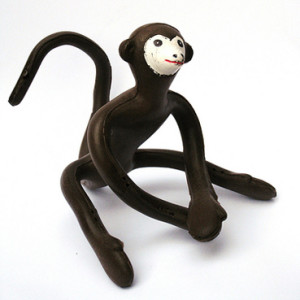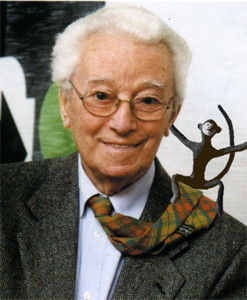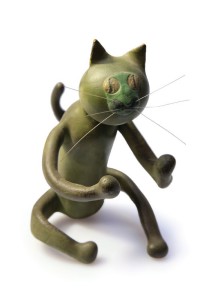Ci sono giocattoli rumorosi, colorati, ripetitivi e commerciali e ci sono oggetti come questo: intelligenti, curiosi, affascinanti ed ecologici, oggi vorrei parlarne con voi…
La scimmietta Zizi è un’imitazione animale in gommapiuma ed armatura leggera in ferro (rivestita in modo sicuro)… E’ piacevole al tatto, malleabile adatta ad ogni età e può assumere tutte le forme che il bambino desidera dare.
Vince il Compasso d’Oro nel 1954 ed è uno dei tanti risultati del grande designer Bruno Munari che per anni ha lavorato accanto ai bambini per studiarne le modalità espressive, di gioco e di apprendimento.
E’ origniale ed ironica e nasce nel 1953 nella gamma di giocattoli in gommapiuma della Pigomma, divisione del marchio Pirelli, sorella minore del gatto Meo Romeo .
La scimmietta mi colpisce perché è simpatica a tutti: è un’ amica per i bambini perché lascia spazio alla loro fantasia, seduto, sdraiato, la fanno camminare, parlare, imitare… diventa protagonista nel gioco di ruoli, si aggrappa e fa le capriole, ti segue ovunque e poi si stacca quando non la vuoi più…
ma a volte si trova sulle scrivanie di manager, di collezionisti d’arte, di personaggi famosi (Picasso aveva un gatto Meo Romeo) e mi piace pensare che queste persone una volta chiusa la porta del loro ufficio diventino bambini e parlino a Zizì, seduta e seriosissima, tutta intenta ad ascoltarli…
Tutto questo senza pile, senza colori sfavillanti, senza lucine…
Merita di essere riprodotto, che ne dite?
There are toys noisy, colorful, repetitive and commercial and there are objects like this: smart, curious, fascinating and today I would like to talk about this object …
The monkey Zizi is an imitation of foam and light armor iron (coated safely) … It is tactile, malleable suitable for all ages and can take any form that the child wishes to give.
Awarded the Compasso d’Oro in 1954 and is one of the many results of the great designer Bruno Munari who for years worked with children to study the modes of expression, play and learning in childhood.
It ‘s original and ironic and was born in 1953 in the range of toys in the foam Pigomma, a division of the Pirelli brand, the younger sister of the cat Meo Romeo.
I love this toyThis toy because leaves children’s immagination free: sitting, lying down, they do walk, talk, imitate … becomes the protagonist in the role play, clings and does somersaults, you follows her everywhere and then comes off when you do not want anymore … but sometimes you find on the desks of managers, art collectors, famous people (Picasso had a cat Meo Romeo) and I like to think that these people once closed port become children and speak to Zizì sitting and serious, intent to listen …
All this without batteries, without sparkling colors, no lights …
Deserves to be reproduced, what do you think?









